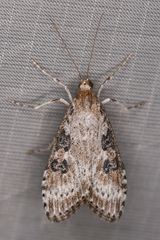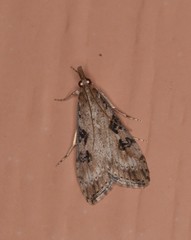Udea turmalis: taxon details and analytics
- Domain
- Kingdom
- Animalia
- Phylum
- Arthropoda
- Class
- Insecta
- Order
- Lepidoptera
- Family
- Crambidae
- Genus
- Udea
- Species
- Udea turmalis
- Scientific Name
- Udea turmalis
Summary description from Wikipedia:
Udea turmalis
Udea turmalis is a moth in the family Crambidae. It was described by Augustus Radcliffe Grote in 1881. It is found in North America, where it has been recorded from Alberta, Arizona, British Columbia, California, Colorado, Idaho, Manitoba, Montana, Nevada, New Mexico, Utah and Washington.
The wingspan is 24–27 mm. Adults are pale dusty ochreous, the costa of the forewings broadly washed with blackish brown, absorbing the rather large dark discal spots. There is an exterior dotted line and a terminal series of blackish dots. The hindwings have a terminal dotted line before the fringes and an extra mesial dotted line, as well as a discal dot. Adults are on wing from June to September.
...Images from inaturalist.org observations:
We recommend you sign up for this excellent, free service.
Parent Taxon
Sibling Taxa
- Udea abstrusa
- Udea accolalis
- Udea adversa
- Udea affinialis
- Udea alaskalis
- Udea albipunctalis
- Udea alpinalis
- Udea angustalis
- Udea annectans
- Udea antipodea
- Udea argoscelis
- Udea aurora
- Udea austriacalis
- Udea autoclesalis
- Udea azorensis
- Udea berberalis
- Udea bipunctalis
- Udea bourgognealis
- Udea brevipalpis
- Udea brontias
- Udea bryochloris
- Udea caliginosalis
- Udea calliastra
- Udea caminopis
- Udea carniolica
- Udea cataphaea
- Udea chalcophanes
- Udea chloropis
- Udea chytropa
- Udea confinalis
- Udea conisalias
- Udea constricta
- Udea conubialis
- Udea costalis
- Udea cretacea
- Udea cyanalis
- Udea daiclesalis
- Udea decoripennis
- Udea decrepitalis
- Udea derasa
- Udea despecta
- Udea donzelalis
- Udea dracontias
- Udea dryadopa
- Udea elutalis
- Udea endopyra
- Udea ennychioides
- Udea ephippias
- Udea epicoena
- Udea eucrena
- Udea exalbalis
- Udea exigualis
- Udea ferrugalis
- Udea fimbriatralis
- Udea fulvalis
- Udea grisealis
- Udea hageni
- Udea hamalis
- Udea helioxantha
- Udea heterodoxa
- Udea hyalistis
- Udea ichinosawana
- Udea indistinctalis
- Udea infuscalis
- Udea inquinatalis
- Udea institalis
- Udea intermedia
- Udea itysalis
- Udea lagunalis
- Udea lampadias
- Udea languidalis
- Udea latipennalis
- Udea lerautalis
- Udea liopis
- Udea litorea
- Udea livida
- Udea lolotialis
- Udea lugubralis
- Udea lutealis
- Udea maderensis
- Udea marmarina
- Udea mechedalis
- Udea melanopis
- Udea melanostictalis
- Udea metasema
- Udea micacea
- Udea montanalis
- Udea montensis
- Udea monticolens
- Udea murinalis
- Udea muscosalis
- Udea nebulalis
- Udea nebulatalis
- Udea nigrescens
- Udea nolalis
- Udea nordeggensis
- Udea nordmani
- Udea notata
- Udea numeralis
- Udea ochreocapitalis
- Udea octosignalis
- Udea olivalis
- Udea ommatias
- Udea orbicentralis
- Udea pachygramma
- Udea pantheropa
- Udea phaethontia
- Udea phyllostegia
- Udea platyleuca
- Udea poasalis
- Udea poliostolalis
- Udea praepetalis
- Udea profundalis
- Udea proximalis
- Udea prunalis
- Udea psychropa
- Udea pyranthes
- Udea radiosalis
- Udea rhabdalis
- Udea rhododendronalis
- Udea rubigalis
- Udea ruckdescheli
- Udea saxifragae
- Udea scorialis
- Udea secernalis
- Udea sheppardi
- Udea simplicella
- Udea stationalis
- Udea stellata
- Udea stigmatalis
- Udea suralis
- Udea swezeyi
- Udea tachdirtalis
- Udea tenoalis
- Udea testacea
- Udea thermantis
- Udea thermantoidis
- Udea torvalis
- Udea tritalis
- Udea turmalis
- Udea uliginosalis
- Udea uralica
- Udea vacunalis
- Udea violae
- Udea washingtonalis
- Udea zernyi















